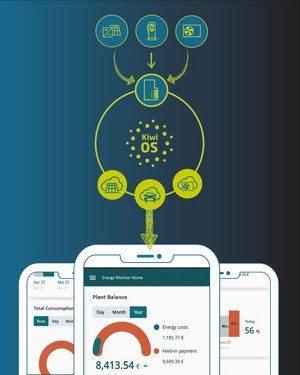For energy market players looking for a way to link different classes of devices such as heat pumps, PV systems, charging stations or electricity storage units in their own homes, there are basically two options for connectivity: cloud-to-cloud or with a local gateway. Which option is most suitable depends on the individual use case. In this blog, we explain the advantages of a gateway network and explain when it can be particularly useful.
A PV system is considered especially cost-effective if it uses as much of its own generated electricity for charging the EV or operating the heat pump as possible. For this specific use case of energy optimization in the home, connecting the various energy devices via a local gateway can offer decisive advantages:
1. Low latency and high speed
PV feed-in and energy consumption in the home fluctuate very strongly over the course of the day and cannot always be anticipated. Only by using a local gateway can it be ensured that the connected devices will be able to respond to fluctuations in PV generation and energy consumption at very short notice. By taking real-time values into account, a local gateway can react much better to the fluctuations than an Internet-based cloud solution, and so can optimize self-consumption and self-sufficiency.
2. Offline capability
Even if the Internet connection is lost, a local gateway is able to continue operating as per predefined rules. The direct connection to the local devices allows data to be read, collected and temporarily stored offline for up to 14 days.
3. Safety
When connecting devices via a gateway, the data of the energy devices is stored locally and thereby offers unbeatable data security.

How gateway connection works
Kiwigrid's Energy Manager (the gateway) acts as an interface between the energy devices and the KiwiOS Energy IoT platform. The gateway collects device data and accesses the functions of the devices directly on command from the platform in order to optimize their operation. This communication usually runs via APIs. In this case, the gateway enables not only the so-called "reading" but also the "writing" of the interfaces - which massively expands the functional diversity of a HEMS, especially through active control options.
With a gateway from Kiwigrid, energy companies, hardware manufacturers and service providers are gearing up for the future of energy supply. Energy market players and installers can choose between the Energy Manager VoyagerX, which can be mounted decentrally, and the Energy Manager Rail, which is typically installed in the control cabinet. Both devices are equipped with powerful processors and are therefore extremely reliable in operation and offer high-performance.

Compact design for fast installation
An advantage of a cloud solution is that no hardware has to be installed, meaning new end customers can be brought on board much faster. However, since installers must always be on site to install the energy devices, this advantage is minimized if a gateway is installed as a plug-and-play directly with the energy device.
Both the Energy Manager VoyagerX and the Energy Manager Rail have a compact design and allow for a quick installation. This applies to installation in new buildings as well as retrofitting in existing buildings. Given the shortage of skilled workers, this is an important feature that should not be overlooked.
Are you interested in home energy device connectivity? Follow us on LinkedIn for more news!
